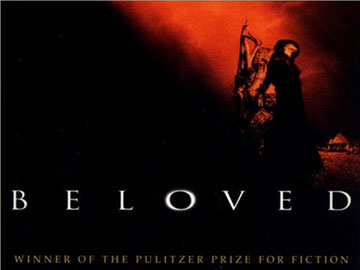Analysis of Beloved J. E. L.1995
Tony Morrison's prize-winning novel, Beloved, reflects the idea that the world is divided into two opposite forms of energy : "feminine" energy which is receptive, integrative, and associated with right-brain perception, and "masculine" energy which is active, incisive, and associated with left-brain perception.
When Sethe kills Beloved, she kills a part of herself ( a mother and infant are so closely bonded that they are almost undifferentiated), just as women are forced to repress an important part of their natures in a left-brain culture. When the men steal Sethe's milk, they rob her of the sustenance she needs for nourishing her own soul (Beloved), as well as other people. In a left-brained world where women are devalued, they are often assigned roles and tasks which drain them of time and energy to tap into their intuitive right-brain natures. This realm is repressed in both men and women, just as Beloved is obliterated without even the acknowlegement of a decent burial. As a mother, I can imagine how traumatic and unspeakable it would be to have to kill your own child. Yet, as we all grow up, we're forced to repress a part of ourselves which is also very precious, our sense of wholeness, spirituality, and connectedness to our source. Beloved is written like a dream, full of metaphors, and in the language of dreams, a baby or a small child often signifies rebirth, and a house often signifies the psyche. Before Sethe kills Beloved, she has 28 happy days which can be seen as a rebirth for her at Sweet Home. But then she is forced to kill this new life, which is her reconnection with the intuitive realm. Like most repressed energy in our psyches, Beloved's energy persistently tries to re-admit itself, angry at being denied life and expression. One of the reasons why pages 210 - 217 are so rambling and illogical is because, in addition to being the pre-verbal thought processes of an infant, they represent the pre-logical perception of the intuitive, unconscious mind. In the last chapter of the book, there's a passage that says "Down by the stream in back of 124 her footprints come and go, come and go. They are so familiar. Should a child, an adult place his feet in them, they will fit. Take them out and they disappear again as though nobody ever walked there. By and by all trace is gone, and what is forgotten is not only the footprints but the water too and what is down there." When we are born into a left-brain culture and emerge into our conscious minds, the collective unconscious recedes from our awareness and we lose touch with our source of spirituality and wholeness. When Beloved comes back, she becomes a healing force. She heals Denver, who has been isolated and lonely, by providing her with inner resources. Beloved dances with Denver, which opens up her sense of play and banishes her feeling of isolation. She encourages Denver to remember her own origins and experience how it must have been for her mother when she (Denver) was born. She developes Denver's capacity for empathy and fosters a closer bond between mother and daughter. Beloved is a healing force for Paul D., too. He is reluctantly drawn to her, because he is repressing the feminine energy within himself. She causes his rusty tin-can of a heart to open, awakening his capacity to love, which had been lost. In a way, Paul D. represents the male experience in general. A restrictive environment had forced his heart to harden. In the white culture, too, the men have undergone a hardening of the heart through cultural conditioning which disapproves of sensitivity in males. After Paul D. leaves Sethe, she is thrown back on her own resources, and she taps into her female energy. She, Denver, and Beloved skate outdoors under the stars and laugh together. The sweetened milk they drink, around the warmth of a fire, represents feminine energy to nourish and sustain them. Sethe ascends the stairs "like a bride" because she is becoming whole again. But eventually she becomes obsessed with her unconscious and is drawn into the unbalanced extreme which is madness. Beloved is resentful for having been abandoned before, and Sethe feels guilty, overly-concerned for Beloved's well-being. Beloved grows plump while Sethe shrinks, like someone who neglects the rational part of their mind while focused inward to unconscious realms. She starts to fade away like Baby Suggs. But Paul D. goes to her and offers her the healing bond of relationship between male and female, conscious and unconscious mind, right and left brain. He tells Sethe that she is "her own best thing", and that he values her because she gathers the pieces of himself and integrates them, a friend of his mind. She adds a sense of wholeness to his divided left-brain world. This is a love story about individuals and, at the same time, the story of the African / American experience and the archetypal story of the human race. When we (and all life) arose from the great ocean of being, at first we retained our connection with our source. After we divided into separate races, nationalities and ideologies, walls were erected between one race verses another, male verses female, thinking verses feeling, science verses art, -etc. Sethe and Paul D. transcend these divisions and discover the saving grace of wholeness.
|
